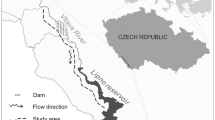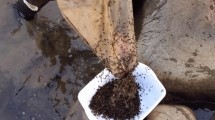Abstract
We hypothesized that fishes in short-hydroperiod wetlands display pulses in activity tied to seasonal flooding and drying, with relatively low activity during intervening periods. To evaluate this hypothesis, sampling devices that funnel fish into traps (drift fences) were used to investigate fish movement across the Everglades, U.S.A. Samples were collected at six sites in the Rocky Glades, a seasonally flooded karstic habitat located on the southeastern edge of the Everglades. Four species that display distinct recovery patterns following drought in long-hydroperiod wetlands were studied: eastern mosquitofish (Gambusia holbrooki) and flagfish (Jordanella floridae) (rapid recovery); and bluefin killifish (Lucania goodei) and least killifish (Heterandria formosa) (slow recovery). Consistent with our hypothesized conceptual model, fishes increased movement soon after flooding (immigration period) and just before drying (emigration period), but decreased activity in the intervening foraging period. We also found that eastern mosquitofish and flagfish arrived earlier and showed stronger responses to hydrological variation than either least killifish or bluefin killifish. We concluded that these fishes actively colonize and escape ephemeral wetlands in response to flooding and drying, and display species-specific differences related to flooding and drying that reflect differences in dispersal ability. These results have important implications for Everglades fish metacommunity dynamics.








Similar content being viewed by others
References
Abrams PA, Cressman R, Křivan V (2007) The role of behavioural dynamics in determining the patch distributions of interacting species. The American Naturalist 169:505–518
Andersen T, Carstensen J, Hernandez-Garcia E, Duarte C (2009) Ecological thresholds and regime shifts: approaches to identification. Trends in Ecology & Evolution 24:49–57
Armsworth PR, Roughgarden JE (2005) The impact of directed versus random movement on population dynamics and biodiversity patterns. The American Naturalist 165:449–465
Brown KL (1985) Demographic and genetic characteristics of dispersal in the mosquitofish, Gambusia affinis (Pisces: Poeciliidae). Copeia 1985:597–612
Brown KL (1987) Colonization by Mosquitofish (Gambusia affinis) of a Great Plains River Basin. Copeia 1987:336–351
Capone TA, Kushlan JA (1991) Fish community structure in dry-season stream pools. Ecology 72:983–992
Chapman LJ, Kramer DL, Chapman CA (1991) Population dynamics of the fish Poecilia gillii (Poeciliidae) in pools of an intermittent tropical stream. Journal of Animal Ecology 60:441–453
Childers DL, Boyer JN, Davis SE, Madden CJ, Rudnick DT, Sklar FH (2006) Relating precipitation and water management to nutrient concentrations in the oligotrophic “upside-down” estuaries of the Florida Everglades. Limnology and Oceanography 51:602–616
Congdon BC (1994) Characteristics of dispersal in the eastern mosquitofish, Gambusia affinis. Journal of Fish Biology 45:943–952
Correa SB, Crampton WGR, Chapman LJ, Albert JS (2008) A comparison of flooded forest and floating meadow fish assemblages in an upper Amazon floodplain. Journal of Fish Biology 72:629–644
Courtenay WR Jr, Meffe GK (1989) Small fishes in strange places: a review of introduced poeciliids. In: Meffe GK, Snelson FF Jr (eds) Ecology and evolution of livebearing fishes (Poeciliidae). Prentice Hall, Englewood Cliffs, pp 319–331
Craighead FC Sr (1971) The trees of South Florida. Vol 1. University of Miami Press, Coral Gables
Cucherousset J, Paillisson J-M, Carpentier A, Chapman LJ (2007) Fish emigration from temporary wetlands during drought: the role of physiological tolerance. Archiv für Hydrobiologie 168:169–178
Davey AJH, Kelly DJ (2007) Fish community responses to drying disturbances in an intermittent stream: a landscape perspective. Freshwater Biology 52:1719–1733
DeAngelis DL, Trexler JC, Loftus WF (2005) Life history trade-offs and community dynamics of small fishes in a seasonally pulsed wetland. Canadian Journal of Fisheries and Aquatic Sciences 62:781–790
DeAngelis DL, Trexler JC, Cosner C, Obaza A, Jopp F (2010) Fish population dynamics in a seasonally varying wetland. Ecological Modelling 221:1131–1137
Fisher RA (1937) The wave of advance of advantageous genes. Annals of Eugenics London 7:355–369
Fretwell SD (1972) Populations in a seasonal environment. Princeton University Press, Princeton
Fretwell SD, Lucas HL Jr (1970) On territorial behavior and other factors influencing habitat distributions in birds. I. Theoretical development. Acta Biotheoretica 19:16–36
Gaiser EE, Trexler JC, Wetzel PR (2012) Chapter 17. The Florida everglades. In: Batzer DP, Baldwin AH (eds) Wetland habitats of North America: ecology and conservation concerns. Univ. California Press, Berkeley, pp 231–252
Jacobson B, Peres-Neto PR (2010) Quantifying and disentangling dispersal in metacommunities: how close have we come? How far is there to go? Landscape Ecology 25:495–507
Jopp F, DeAngelis DL, Trexler JC (2010) Modeling seasonal dynamics of small fish cohorts in fluctuating freshwater marsh landscapes. Landscape Ecology 25:1041–1054
Killick R, Eckly IA (2012) Changepoint: An R package for changepoint analysis. R package version 0.7. http://CRAN.R-project.org/package=changepoint
Leibold MA, Holyoak M, Mouquet N, Amarasekare P, Chase JM, Hoopes MF, Holt RD, Shurin JB, Law R, Tilman D, Loreau M, Gonzalez A (2004) The metacommunity concept: a framework for multi-scale community ecology. Ecology Letters 7:601–613
Loftus WF, Bruno MC, Cunningham KJ, Perry SA, Trexler JC (2001) The ecological role of the karst wetlands in southern Florida in relation to system restoration. U.S. Geological Survey Karst Interest Group Proceedings 01–4011
Lowe-McConnell RH (1987) Ecological studies in tropical fish communities. Cambridge University Press, Cambridge
Lytle DA, Poff NL (2004) Adaptation to natural flow regimes. Trends in Ecology and Evolution 19:94–100
Magoulick DD, Kobza RM (2003) The role of refugia for fishes during drought: a review and synthesis. Freshwater Biology 48:1186–1198
McElroy TC, Kandl KL, Trexler JC (2011) Temporal population-genetic structure of eastern mosquitofish in a dynamic aquatic landscape. Journal of Heredity 102:678–687
Mosepele K, Moyle PB, Merron GS, Purkey DR, Mosepele B (2009) Fish, floods, and ecosystem engineers: aquatic conservation in the Okavango Delta, Botswana. Bioscience 59:53–64
Nams VO (2006) Detecting oriented movement of animals. Animal Behaviour 72:1197–1203
Obaza A, DeAngelis DL, Trexler JC (2011) Using data from an encounter sampler to model fish dispersal. Journal of Fish Biology 78:495–513
Perry GLW, Bond NB (2009) Spatially explicit modeling of habitat dynamics and fish population persistence in an intermittent lowland stream. Ecological Applications 19:731–746
Pyke GH (2008) Plague minnow or mosquito fish? A review of the biology and impacts of introduced Gambusia species. Annual Review of Ecology, Evolution, and Systematics 39:171–191
Rayner TS, Pusey BJ, Pearson RG (2008) Seasonal flooding, instream habitat structure and fish assemblages in the Mulgrave River, north-east Queensland: towards a new conceptual framework for understanding fish-habitat dynamics in small tropical rivers. Marine and Freshwater Research 59:97–116
R Core Team (2012) R: A language and environment for statistical computing. R Foundation for Statistical Computing, Vienna, Austria. http://www.R-project.org/
Rehage JS, Sih A (2004) Dispersal behavior, boldness, and the link to invasiveness: a comparison of four Gambusia species. Biological Invasions 6:379–391
Resetarits WJ Jr (2001) Colonization under threat of predation: avoidance of fish by an aquatic beetle, Tropisternus lateralis (Coleoptera: Hydrophilidae). Oecologia 129:155–160
Ruetz C, Trexler JC, Jordan F, Loftus WF, Perry SA (2005) Population dynamics of wetland fishes: spatio-temporal patterns synchronized by hydrological disturbance? Journal of Animal Ecology 74:322–332
Sadeh A, Truskanov N, Mangel M, Blaustein L (2011) Compensatory development and costs of plasticity: larval responses to desiccated conspecifics. PLoS One 6:e15602. doi:10.1371/journal.pone.0015602
Schofield PJ, Loftus WF, Kobza RM, Cook MI, Slone DH (2009) Tolerance of nonindigenous cichlid fishes (Cichlasoma urophthalmus, Hemichromis letourneuxi) to low temperature: laboratory and field experiments in south Florida. Biological Invasions 12:2441–2457
Segev O, Mangel M, Wolf N, Sadeh A, Kershenbaum A, Blaustein L (2011) Spatiotemporal reproductive strategies in the fire salamander: a model and empirical test. Behavioral Ecology 22:670–678
Skellam JG (1951) Random dispersal in theoretical populations. Biometrika 38:196–218
Trexler JC, Goss CW (2009) Aquatic fauna as indicators for Everglades restoration: applying dynamic targets in assessments. Ecological Indicators 9:S108–S119
Trexler JC, Loftus WF, Perry SA (2005) Disturbance frequency and community structure in a twenty-five year intervention study. Oecologia 145:140–152
Acknowledgments
This publication was produced for a special issue devoted to investigating the ecological response of over 20 years of hydrologic restoration and active management in the Taylor Slough drainage of ENP. Support was provided by ENP, the Southeast Environmental Research Center, the Florida Coastal Everglades Long-Term Ecological Research program (National Science Foundation cooperative agreement #DBI-0620409), the Everglades Foundation, and the South Florida Water Management District. We greatly appreciate the help of technicians who built the arrays, tested sampling gear, and processed samples: V. Foster, R. Kobza, D. Padilla, X. Pagan, D. Riggs, H. Waddle, A. Martin, B. Shamblin, and R. Urguelles. B. Zepp saw us through the ENP permit process and Dr. S. Howington supported our work as NPS CESI coordinator and project administrator. D. Elswick and C. Fadeley of USGS helped with budget and personnel needs. WFL was supported in part by funds from the Critical Ecosystem Studies Initiative (CESI) Interagency Cooperative Agreement between USGS and NPS # 5280-7-9023. CWG and JCT were supported in part by Critical Ecosystem Studies Initiative (CESI) Cooperative Agreement H50000 06 0104, tasks J5284 06 0023 and J5284 06 0020 between FIU and the National Park Service while working on this project.
Author information
Authors and Affiliations
Corresponding author
Rights and permissions
About this article
Cite this article
Goss, C.W., Loftus, W.F. & Trexler, J.C. Seasonal Fish Dispersal in Ephemeral Wetlands of the Florida Everglades. Wetlands 34 (Suppl 1), 147–157 (2014). https://doi.org/10.1007/s13157-013-0375-3
Received:
Accepted:
Published:
Issue Date:
DOI: https://doi.org/10.1007/s13157-013-0375-3




